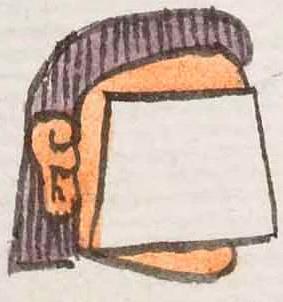ixtli (Mdz21v)
This element for eyes or face (ixtli) has been carved from the compound sign for the place name, Ixquemecan. The covering on the face is called a quemitl), a type of ritual vestment usually worn on the chest.
Stephanie Wood
We see a man's head, but the eyes and face (ixtli) is covered with a trapezoid shaped white covering, inadvertently calling attention to it. That this person is male derives from his haircut and hair style. If uncovered, this could be a three-quarters view of the face or even a frontal view, something rare. But perhaps because it is covered, and in order to show how the quemitl was worn on the face, the perspective is frontal.
We cannot tell if the quemitl would be paper or cloth. Both are possibilities, for both had ritual uses, as the quemitl was a ritual garment.
Stephanie Wood
Stephanie Wood
c. 1541, but by 1553 at the latest
Stephanie Wood

ix(tli), eye, eyes, face, https://nahuatl.wired-humanities.org/content/ixtli
quemi(tl), vestment, bib, https://nahuatl.wired-humanities.org/content/quemitl
-can (locative suffix), https://nahuatl.wired-humanities.org/content/can-2
eyes
el rostro, el ojo
Stephanie Wood
Codex Mendoza, folio 21 verso, https://digital.bodleian.ox.ac.uk/objects/2fea788e-2aa2-4f08-b6d9-648c00..., image 53 of 188.
The Bodleian Libraries, University of Oxford, hold the original manuscript, the MS. Arch. Selden. A. 1. This image is published here under the UK Creative Commons, “Attribution-NonCommercial-ShareAlike 3.0 License” (CC-BY-NC-SA 3.0).


